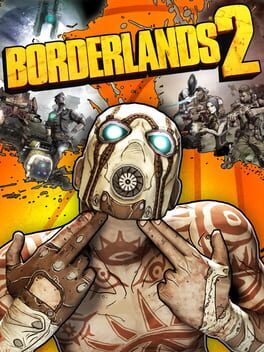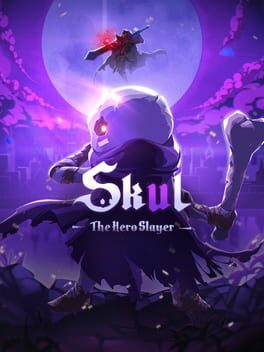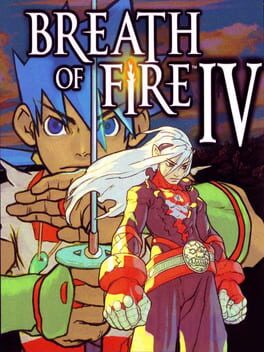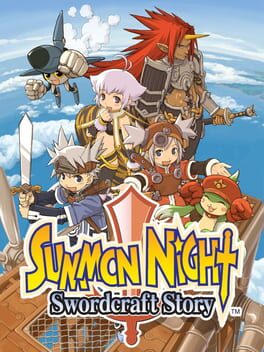Shades4ever
2012
I'm honestly more mixed than I should be on this one. It was a fairly fun time revisiting this game and caring about loot farming and getting good rolls until I went to UVHM, which is NG++. Between the exhaustion of trying to farm for a good gun (and then losing it to my stupidity) and the sheer tedium of going through the game a third time, I was pretty done with it while storming the Bloodshot Stronghold for the third time. You really feel when you don't have slag applied to an enemy, and that really made things worse for me. Seeing normal enemies take millions of damage to kill is only fun if you can consistently do millions, and I was not really able to do that without certain gear or slag. Some quests also went from neat to a complete slog due to enemies having health regen on top of heavily inflated stats.
Outside of that tho, the story was alright. It has moments where it drags, and it has some solid peaks. Handsome Jack remains a solid villain that you love to hate and boy is it easy to hate him. I can't say much about the DLC stories mainly cause my original plan was to do them with a full build on UVHM.
The gameplay of BL2 doesn't feel like it offers much you can't get elsewhere. You really only get crazy effects on guns if you farm for legendaries, which can be quite time consuming and will likely require a guide on who to farm and how to farm fast. The skill trees didn't feel like much beyond stats for the character I played (Axton). I felt somewhat squishy at most points even with an on-level shield. Enemy DoTs were especially deadly, as it felt like one corrosion or shock proc and I'd be down 70% or more health.
In spite of my complaints, it's still a solid experience the one playthrough. I think it's a shame most people won't experience the more interesting weapons in that playthrough, and the game feels like you should go multiplayer instead of solo.
Outside of that tho, the story was alright. It has moments where it drags, and it has some solid peaks. Handsome Jack remains a solid villain that you love to hate and boy is it easy to hate him. I can't say much about the DLC stories mainly cause my original plan was to do them with a full build on UVHM.
The gameplay of BL2 doesn't feel like it offers much you can't get elsewhere. You really only get crazy effects on guns if you farm for legendaries, which can be quite time consuming and will likely require a guide on who to farm and how to farm fast. The skill trees didn't feel like much beyond stats for the character I played (Axton). I felt somewhat squishy at most points even with an on-level shield. Enemy DoTs were especially deadly, as it felt like one corrosion or shock proc and I'd be down 70% or more health.
In spite of my complaints, it's still a solid experience the one playthrough. I think it's a shame most people won't experience the more interesting weapons in that playthrough, and the game feels like you should go multiplayer instead of solo.
Skul is one of the best roguelikes I've played. It gives the player a lot of freedom as to how to play and build while still remaining a challenge even after a good 200 hours. The final boss still finds new ways to end runs, which is equal part impressive and bs.
My problems with Skul really boil down to two general complaints. The first is that it feels like hitboxes linger for longer than they should. This is at its worst against a few bosses and a few hard mode enemies, but man does it feel bad to dodge through a move and still get hit by it. The other problem is that, at higher hard mode levels, there is less overall freedom in builds due to enemy stat inflation. This one can be remedied a good bit by playing on lower difficulties, but I still wanted to point it out. You can get away with more wild and less high damage builds on level 8-10 as long as the item/skull synergy is there and you play well.
There are three big positives that I want to touch on here: item balance, skull balance, and hard mode. Item balance is done extremely well in this. There have been plenty of runs where I'd bring a common item or 3 into the final boss because they are still good. A lot of the rare and unique (tier 2 and 3 respectively) items often have stronger but conditional effects to them, meanwhile a lot of common items are stats. Beyond that, the inscriptions are another key factor here. Inscriptions are like set bonuses, and every item comes with 2 of them. It is a solid decision most of the time to keep an item purely for its inscriptions if you can't easily replace them.
Skulls are essentially your class/characters in this game. You can have two of them at a time, and swap them out throughout the run. Like with items, skulls have a rarity assigned to them. Unlike with items, skulls can be upgraded. This makes the game so much more interesting to me, as every skull is viable and sometimes you might want to keep a skull in a lower tier. There's a healthy variety of skulls to choose from, and they each have 4 skills to utilize, altho you only get to use 2 at a time. These skills can sometimes completely change what items you want for your build.
Last and certainly not least is the hard mode, aka the dark mirror. This may be the best implementation of a hard mode I've seen. It upgrades the bosses, adds a new element to the adventurer fights, adds new enemies, and gives the player new advantages for each level you complete. That last part is what sold me on it the most, as a lot of games only stack the odds against the player. You get things like being able to choose your starting gear, stat upgrades for excess bones, a machine to lock in 2 different inscriptions, etc. Also, these upgrades are permanent. You can go down to a lower level and keep these benefits without needing to deal with the increased stats or new enemies.
Skul is a phenomenal roguelike. It will beat you relentlessly for a good while, but it also isn't merciless. There are a lot of things to play with and I'm still finding fun combos after 200 hours of playing.
My problems with Skul really boil down to two general complaints. The first is that it feels like hitboxes linger for longer than they should. This is at its worst against a few bosses and a few hard mode enemies, but man does it feel bad to dodge through a move and still get hit by it. The other problem is that, at higher hard mode levels, there is less overall freedom in builds due to enemy stat inflation. This one can be remedied a good bit by playing on lower difficulties, but I still wanted to point it out. You can get away with more wild and less high damage builds on level 8-10 as long as the item/skull synergy is there and you play well.
There are three big positives that I want to touch on here: item balance, skull balance, and hard mode. Item balance is done extremely well in this. There have been plenty of runs where I'd bring a common item or 3 into the final boss because they are still good. A lot of the rare and unique (tier 2 and 3 respectively) items often have stronger but conditional effects to them, meanwhile a lot of common items are stats. Beyond that, the inscriptions are another key factor here. Inscriptions are like set bonuses, and every item comes with 2 of them. It is a solid decision most of the time to keep an item purely for its inscriptions if you can't easily replace them.
Skulls are essentially your class/characters in this game. You can have two of them at a time, and swap them out throughout the run. Like with items, skulls have a rarity assigned to them. Unlike with items, skulls can be upgraded. This makes the game so much more interesting to me, as every skull is viable and sometimes you might want to keep a skull in a lower tier. There's a healthy variety of skulls to choose from, and they each have 4 skills to utilize, altho you only get to use 2 at a time. These skills can sometimes completely change what items you want for your build.
Last and certainly not least is the hard mode, aka the dark mirror. This may be the best implementation of a hard mode I've seen. It upgrades the bosses, adds a new element to the adventurer fights, adds new enemies, and gives the player new advantages for each level you complete. That last part is what sold me on it the most, as a lot of games only stack the odds against the player. You get things like being able to choose your starting gear, stat upgrades for excess bones, a machine to lock in 2 different inscriptions, etc. Also, these upgrades are permanent. You can go down to a lower level and keep these benefits without needing to deal with the increased stats or new enemies.
Skul is a phenomenal roguelike. It will beat you relentlessly for a good while, but it also isn't merciless. There are a lot of things to play with and I'm still finding fun combos after 200 hours of playing.
2000
This game is absolutely amazing. I have a few problems with it here and there, but this replay confirmed my thoughts of this being one of the best RPGs on the PS1. It has a good story, a mostly solid cast of characters, a villain you want to murder, and a battle system that allows a good amount of flexibility.
Let's start with the problems I have. The first, and probably biggest one, is that the dragon system in this game is a large step down from what was in Breath of Fire 3. The Dragon Gene system in that game had so much potential and rewarded players even more for exploring. The 6 different forms here, while still a strong tool, are not nearly as diverse.
You also get access to the strongest form before you can finish collecting the elemental forms. There's also minimal side content in this game. The closest I can think of is finding the Endless, but the story leads you to do that and there's a massive (and unsaid) reward for doing so. The last problem isn't exactly the game's fault. Some scenes have either been cut short or removed altogether. If I recall correctly, this was made at a time when real videogame censorship was a problem in the US. The only important scene that was altered featured a character getting decapitated, so it's easy to see why that was cut. There's also a party member who went from being drunk fairly frequently to having a mean stutter.
With all that said, let's get into what makes this game so good from a gameplay perspective. First, it has greatly improved quality of life features compared to BoF3. Masters don't teach you skills strictly from gaining levels while training under them, you can reassign masters from diaries, learning skills from enemies is tied to the guard command instead of a "watch" command, the list goes on. Probably the most notable change there is the ability to switch party members in and out of battle. Need Cray to push a boulder but he's not in the main party? Just open the menu and switch him in. You don't have to back all the way out of a dungeon this time to make that change. Battles also let you use everyone, with 3 of them being active/in the front row. Those in the back regain a set amount of AP per turn. All of that combined with some new mechanics let you actually use the whole team instead of just 2 non-Ryu characters. And with the master system, characters can go into whatever role you want. They may not be the most effective in those roles, but nothing is stopping you from creating physical Nina and mage Cray.
I'm not going to talk about the story since it's one of the best parts about the game. I want people to go in while knowing as little of it as possible. With that said, I feel the story doesn't overstay its welcome. My replay took about 31 hours, with about 30-60 minutes of that being AFK.
All in all, this game was a treat to go back to. It can definitely be a harder game to replay since its story means a lot more than say BoF3, but that also makes the first playthrough so much better.
Let's start with the problems I have. The first, and probably biggest one, is that the dragon system in this game is a large step down from what was in Breath of Fire 3. The Dragon Gene system in that game had so much potential and rewarded players even more for exploring. The 6 different forms here, while still a strong tool, are not nearly as diverse.
You also get access to the strongest form before you can finish collecting the elemental forms. There's also minimal side content in this game. The closest I can think of is finding the Endless, but the story leads you to do that and there's a massive (and unsaid) reward for doing so. The last problem isn't exactly the game's fault. Some scenes have either been cut short or removed altogether. If I recall correctly, this was made at a time when real videogame censorship was a problem in the US. The only important scene that was altered featured a character getting decapitated, so it's easy to see why that was cut. There's also a party member who went from being drunk fairly frequently to having a mean stutter.
With all that said, let's get into what makes this game so good from a gameplay perspective. First, it has greatly improved quality of life features compared to BoF3. Masters don't teach you skills strictly from gaining levels while training under them, you can reassign masters from diaries, learning skills from enemies is tied to the guard command instead of a "watch" command, the list goes on. Probably the most notable change there is the ability to switch party members in and out of battle. Need Cray to push a boulder but he's not in the main party? Just open the menu and switch him in. You don't have to back all the way out of a dungeon this time to make that change. Battles also let you use everyone, with 3 of them being active/in the front row. Those in the back regain a set amount of AP per turn. All of that combined with some new mechanics let you actually use the whole team instead of just 2 non-Ryu characters. And with the master system, characters can go into whatever role you want. They may not be the most effective in those roles, but nothing is stopping you from creating physical Nina and mage Cray.
I'm not going to talk about the story since it's one of the best parts about the game. I want people to go in while knowing as little of it as possible. With that said, I feel the story doesn't overstay its welcome. My replay took about 31 hours, with about 30-60 minutes of that being AFK.
All in all, this game was a treat to go back to. It can definitely be a harder game to replay since its story means a lot more than say BoF3, but that also makes the first playthrough so much better.
This was a game I played quite a bit of growing up. It takes many elements from the first game and enhances them, while losing a tiny bit of the charm the first game had. Instead of a tournament arc in a city, the game starts you off in a village with a more typical fantasy journey. You explore a greater range of locals and enjoy better visual variety. The game still has the post chapter chats with characters, only this time all the guardian beasts can speak english.
The gameplay has received a number of changes. First, durability damage remains after fights but drains far slower. Next, there are weapon techniques that can be added to spice up the gameplay. A good number of these are shared, but there are also some exclusive not only to weapon types but also specific weapons. The guardian beasts offer a little more variety by having 3 unique spells as opposed to 1, although these spells are very similar. The way you make weapons changed in a way that makes breaking people's weapons matter regardless of what weapon types you want to use.
That all being said, the game still has some problems. The story feels a good bit more generic compared to the first. The different guardian beasts still don't add much variety in gameplay. If you want to see what each ore makes, you either have to save and reload after each weapon or fish up enough points to buy the ore in the next chapter.
Like the first game, it's a solid first playthrough. The added variety gives it enough of an edge for me to prefer this one to the first.
The gameplay has received a number of changes. First, durability damage remains after fights but drains far slower. Next, there are weapon techniques that can be added to spice up the gameplay. A good number of these are shared, but there are also some exclusive not only to weapon types but also specific weapons. The guardian beasts offer a little more variety by having 3 unique spells as opposed to 1, although these spells are very similar. The way you make weapons changed in a way that makes breaking people's weapons matter regardless of what weapon types you want to use.
That all being said, the game still has some problems. The story feels a good bit more generic compared to the first. The different guardian beasts still don't add much variety in gameplay. If you want to see what each ore makes, you either have to save and reload after each weapon or fish up enough points to buy the ore in the next chapter.
Like the first game, it's a solid first playthrough. The added variety gives it enough of an edge for me to prefer this one to the first.
While I do prefer the combat changes in the second game, this game still laid the baseline for what that game would use. The general area of Wystern is interesting and the presence of craftknights makes a lot of sense in this game. The story has you go through a tournament arc to decide who takes your late father's place among the craftlords. It is an alright story, and the chats with a selected character is fun and gives you something extra on replays.
Gameplaywise, it feels like an early 2D Tales of game. You don't have many attack options, but it plays well and still offers something fun. You'll have to fight against other people throughout the story, and you can break their weapons in order to craft your own version.
The main thing that makes me go back to this less is the lack of variety in combat. The guardian beasts decide the order you learn spells and how many charges you get, but that's about it. The weapons lack any technique and forging options to mess with the attributes of a given weapon. This makes combat feel a bit braindead at times, especially if you aren't fighting a human. Speaking of, breaking someone's weapon will feel pointless if you don't plan on using that weapon type. If you only want to use knuckles and drills, you'll have very little reason to fight characters that specific way. The game can also get visually dull at times, since it mostly takes place in the labyrinth.
This is a solid game for the first playthrough, but is less appealing on repeat playthroughs since its combat is less developed compared to other games.
Gameplaywise, it feels like an early 2D Tales of game. You don't have many attack options, but it plays well and still offers something fun. You'll have to fight against other people throughout the story, and you can break their weapons in order to craft your own version.
The main thing that makes me go back to this less is the lack of variety in combat. The guardian beasts decide the order you learn spells and how many charges you get, but that's about it. The weapons lack any technique and forging options to mess with the attributes of a given weapon. This makes combat feel a bit braindead at times, especially if you aren't fighting a human. Speaking of, breaking someone's weapon will feel pointless if you don't plan on using that weapon type. If you only want to use knuckles and drills, you'll have very little reason to fight characters that specific way. The game can also get visually dull at times, since it mostly takes place in the labyrinth.
This is a solid game for the first playthrough, but is less appealing on repeat playthroughs since its combat is less developed compared to other games.




